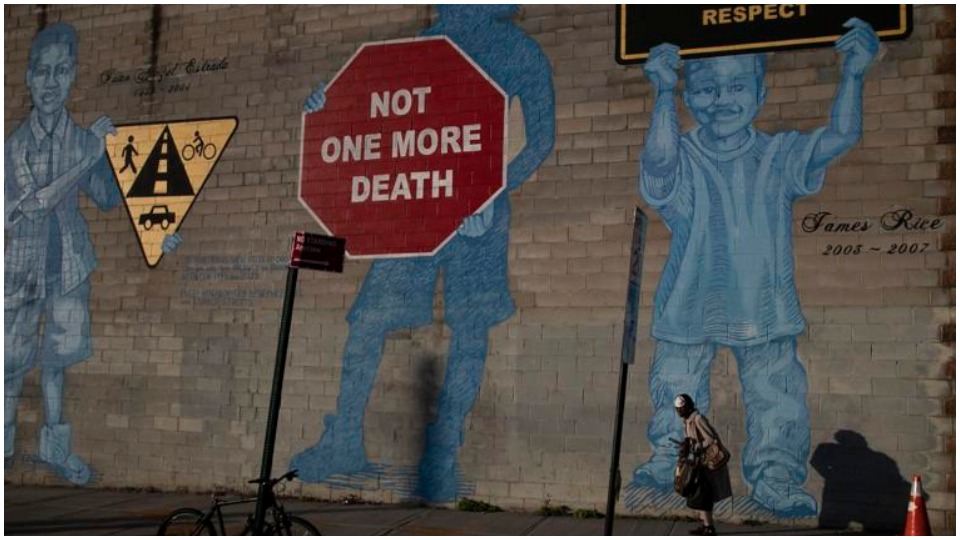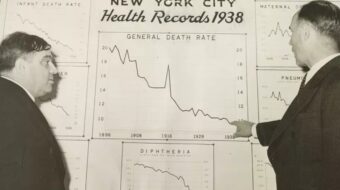
The COVID-19 pandemic is sparking something akin to a social epiphany.
The virus has precipitated an unprecedented global public health, economic, and social crisis. By the time a vaccine is developed, millions will be infected, and tens of thousands will die, with the highest toll among the most vulnerable and marginalized communities and the global South.
The pandemic has laid bare the structural inequalities of global capitalism and its inability to meet basic human needs. Financial institutions are warning the global economic crisis, coming on top of already existing profound structural instability, could be more significant than the 2008 Great Recession, possibly on the scale of the Great Depression. U.S. unemployment is projected to exceed 30%, surpassing the 24% of the Depression years.
It is doubtful an economic recovery will begin without a vaccine, not anticipated for another year, perhaps even two. The health, livelihoods, homes, life savings, and retirement security of tens of millions of working families are threatened.
The economic crisis and pandemic are appearing alongside other interlocking global crises: the ecological and climate crisis, militarization and nuclear proliferation, and extreme wealth and social inequality. The pandemic has accelerated the assault on democratic rights by Trump, the GOP, and their extremist right-wing corporate backers, who prefer a presidential dictatorship.
U.S. society and the world are at a historic turning point. There is no going back to life before the pandemic. Only the comprehensive mobilization of all social and economic resources, coupled with significant structural changes, can address these crises. This cannot be achieved without first defending democracy and defeating Trump and the GOP in the 2020 elections.
Exposé of GOP bankruptcy
The interlocking crises may also be accelerating the political death spiral of the Republican Party. The GOP’s ideological and political bankruptcy is plain to see. The GOP has no solutions for this crisis, and those it does have, serve to make things worse.
The modern extreme right, embodied in the GOP, is backed by the most reactionary sections of Wall Street. The GOP’s only policies during the Obama presidency, when the administration was dealing with a global financial crisis, were to make him a one-term president through total obstruction and sabotage.
The GOP’s ideological and political bankruptcy and its embrace of white supremacy created an opening for the insurgent Tea Party and Trump to take over its apparatus. The GOP is now a cult around Trump, who is leading it deeper into a morass of corruption, authoritarianism, and fascism.
The GOP’s sole objective is to maintain power as a regime party at all costs through the dissolution of democratic institutions and the right to vote. Trump has repeatedly stated he is above the law and all-powerful. This is a prescription for fascism.
Destroying the role of government
Grover Norquist, a leading ideologue of the modern extreme right, famously said, “My goal is to cut government in half in twenty-five years, to get it down to the size where we can drown it in the bathtub.” Under Trump, this is what Steve Bannon calls the “deconstruction of the administrative state.”

The aim is to destroy the role of government in meeting the collective needs of society by dismantling every gain of the New Deal and Great Society eras. Meanwhile, it uses the government to facilitate the concentration of wealth. Consequently, the NSA office on pandemics was dissolved, deep cuts were proposed to the CDC budget, FEMA’s budget was raided to pay for ICE detention facilities, and scores of critical positions across the administration remain unfilled.
The government has been rendered ill-equipped to deal with both the immediate and long-term public health and economic crises. The Trump administration refuses to advance a single national strategy toward the pandemic. Every state and every person is “on their own.”
Decisive action to develop testing and enforce social distancing was delayed for crucial weeks because Wall Street came before public health. Refusal to employ the Defense Production Act and promote worker protections left millions defenseless against the ravages of COVID-19. And now, Trump is dangerously pushing to re-open the economy by May 1, against the advice of public health officials and governors.
The GOP’s solutions are always the same. In essence, let the “free market” work, massive tax cuts for the wealthy, and economic austerity and obliteration of all worker, consumer, and environmental protections for the rest of us.
They aim to dismantle social benefit programs, especially the Affordable Care Act, Medicare, and Medicaid, and SNAP, formerly known as food stamps. Seventy million Americans are without health insurance or are underinsured, and 11 million undocumented immigrants are without health and unemployment insurance in the middle of a deadly pandemic.
The crisis is bankrupting states and cities that have been starved of federal funding by the GOP for decades.
The GOP Senate’s first response was to dole out hundreds of billions to corporations and the wealthy without oversight, and little for working people. The worst was blocked by Democrats, who insisted on extending economic and health lifelines to working families.
Trump’s “America First” economic nationalism, and anti-China racism prevents global cooperation against the coronavirus, including jointly developing a vaccine. The insanity of this approach played out in the administration’s decision to cut funding to the WHO.
Building unity and contesting the post-pandemic world
Our world is undergoing fundamental change. There is no going back to what was. The future is being fiercely contested, and what emerges depends on the class and social balance of forces and the political environment in which the battle is waged.
For starters, Trump and the GOP must be ousted in the 2020 elections. And this won’t be possible without defending the right to vote and existing democratic institutions, no matter how limited and tattered. It will take electing what Joe Biden termed “the most progressive administration since Franklin Roosevelt.”
To combat the Great Depression and bring economic relief to millions of working people, the FDR administration and Democratic Congress passed landmark legislation. It included unemployment insurance, Social Security, the right to form unions and bargain collectively, and massive job creation programs like the Works Project Administration and Civilian Conservation Corps.

But none of these policies were possible without a mass working-class and people’s upsurge, a “popular and democratic front,” including an enormous socialist and communist left, in alliance with a section of the capitalist class.
Then as now, this alliance faced an extreme right and fascist threat.
By channeling this upsurge into the electoral arena and electing Roosevelt in 1932 and building on the Democratic Congressional majority in 1934, the door was opened for everything that followed. Every economic, social, and political gain of the 1930s and ’40s depended on the strength of the mass democratic movements and unity of the overall alliance.
The contemporary expression of the “popular and democratic front” is the alliance in and with today’s Democratic Party. It expresses the broad alliance needed at this stage of a much longer revolutionary struggle for full economic and political democracy, or socialism.
After Trump’s victory in 2016, the resistance coalesced in this electoral alliance, which won big victories in 2018, 2019, and even this year. It is uniting around the Democratic presidential candidacy of Biden, beginning with the endorsements of President Obama and Sens. Sanders and Warren and support of mass democratic movements.
Shaping the program uniting this diverse electoral alliance is an ongoing process. The democratic movements, during the primaries through the candidacies of Sanders and Warren, are driving the issues. While there is growing unity around a general orientation, how the needs of working people, the nationally and racially oppressed, women, youth, and others are addressed continues to be contested.
Broad left-center unity is critical to this process. Neither the left nor the center can prevail alone, and how differences between them are dealt with will be decisive. The establishment of issue panels by Biden and Sanders to work on disagreements reflects the overriding desire for unity to defeat Trump.
The Democratic Party has moved in a politically progressive direction in response to changes in society and the mass democratic movements. In his endorsement of Biden, Obama said the policies that guided him in 2008 are not adequate for today. The world is a very different place and requires new solutions, including big structural change.
This electoral alliance is gathering under policies that orient toward the role of government for the common good, guided by science and public health officials to tackle the pandemic with a single national response.
They orient toward global cooperation to combat the pandemic and climate change.
They orient toward a $15 minimum wage, student debt relief, extending and beefing up unemployment insurance and paid sick leave, and taxing the wealthy. They orient toward universal health care with a public option and expanding Medicare, sustainability, infrastructure modernization, housing construction, steps toward decarceration, and providing resources to states and municipalities.
How far the transformative changes go depends on breaking the resistance of the GOP and the reactionary section of capital backing it. It also depends on the strength and unity of the democratic and people’s movements, because the alliance is made up of contending class and social forces.
A more favorable political environment creates space to make significant gains for the working class and people. To win policies that redistribute wealth, achieve racial and gender equality, protect and expand worker’s rights, Medicare for All, a Green New Deal, cancel student debt, end mass incarceration, and win immigration reform with a path to citizenship.
A different world will emerge from this horrendous moment. Winning transformative radical social, political, and economic democracy and a truly equitable and sustainable society begins in the here and now and in the battle to oust Trump and the GOP in November.
Like free stuff? So do we. Here at People’s World, we believe strongly in the mission of keeping the labor and democratic movements informed so they are prepared for the struggle. But we need your help. While our content is free for readers (something we are proud of) it takes money — a lot of it — to produce and cover the stories you see in our pages. Only you, our readers and supporters, can keep us going. Only you can make sure we keep the news that matters free of paywalls and advertisements. If you enjoy reading People’s World and the stories we bring you, support our work by becoming a $5 monthly sustainer today.












Comments